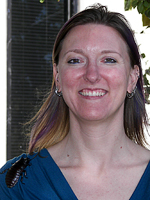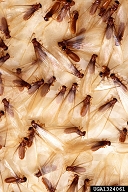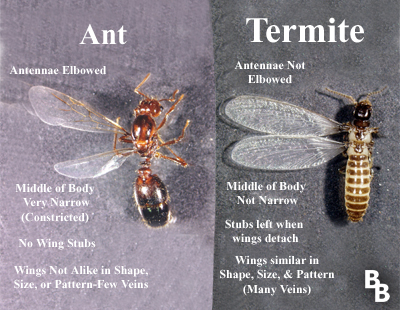Watch for Flying Objects
Soon it will be time for swarming insects to emerge out from their homes in the ground and fly into the air in search of a mate. Usually, this event coincides with warm temperatures and a significant rainfall event but can also occur if you forget to turn off your irrigation system.
“Swarmer” or “alate” are other terms that describe the reproductive stage of ants and termites. These insects have wings when they initially leave the colony, but the wings are either shed or chewed off after they land on the ground and before they form a nest. So, how do you tell them apart?
Ant Swarmers Identification
Ant swarmers antennae are bent or “elbowed” at a ninety-degree angle. The thorax and abdomen meet at a constricted, narrowed, or pinched waist. If you find a reproductive that still has wings- they chew off their wings once they have mated and land on the ground- the front wing will be larger than the hind wing and all wings will have few veins. If the wings are missing from the ant swarmer, there will not be a wing stub left on the thorax from where the wing was attached. Male ant swarmers retain their wings after landing on the ground, but they die after mating.
Termite Swarmers Identification
Termite swarmers have antennae that are straight and a thorax-abdomen area, or “waist”, that is broadly joined together. Their reproductive wings are similar in size and shape and tend to have a lot of veins. Sometimes with termites you may find only wings that have been left behind due to shedding when the termites land on the ground or you may see the termites themselves with or without wings still attached. If you find a termite reproductive without wings, there will be wing stubs, called “scales”, left behind on the thorax. Male and female termite reproductives shed their wings after landing on the ground, pair up, and find a site to begin a new colony.
For more information or help with identification, contact Wizzie Brown, Texas AgriLife Extension Service Program Specialist at 512.854.9600.
About Wizzie

Wizzie Brown
County Extension Program Specialist – Integrated Pest Management
Email:EBrown@ag.tamu.edu
Wizzie has been with Texas A&M AgriLife Extension Service since 2002 and has been playing with insects since she was a toddler. She is an Extension Program Specialist with the Integrated Pest Management (IPM) program. Wizzie holds a B.S. in entomology from The Ohio State University and a M.S. in entomology from Texas A&M University. The integrated pest management program provides identification, biological and management information to whomever needs help. Wizzie’s research focuses on imported fire ants, including community wide fire ant management. Wizzie also is happy to provide programs to area groups on a variety of arthropod-related topics. You can find insect and other arthropod information on Wizzie’s blog.


